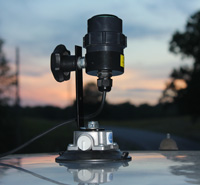Main Content
Article
Acoustic Monitoring of Bats
 Acoustic bat surveys were developed as a non-invasive method to monitor the statewide distribution and relative abundance of bat populations in their summer range. Bats maneuver through their environment and detect prey using echolocation, a process in which they emit ultrasonic sound waves and listening for the echo to return. Advances in technology have resulted in equipment that is able to record echolocation calls which can then be used to identify different bat species by their unique echolocation signatures.
Acoustic bat surveys were developed as a non-invasive method to monitor the statewide distribution and relative abundance of bat populations in their summer range. Bats maneuver through their environment and detect prey using echolocation, a process in which they emit ultrasonic sound waves and listening for the echo to return. Advances in technology have resulted in equipment that is able to record echolocation calls which can then be used to identify different bat species by their unique echolocation signatures.
Mobile Acoustic Bat Surveys
Project personnel use an ultrasonic bat detector and vehicle-mounted microphone to record echolocation calls emitted by bats in the environment. Surveyors drive a predetermined route (15–25 miles in length) shortly after sunset when bats become active. Surveys are conducted two times in a given area across a six week survey period that begins in June and ends in mid-July. The same routes are surveyed each summer, allowing biologists to monitor multiple species of bats through time and across the state.
Wildlife Science staff oversee numerous projects with decades of invaluable data that are used to understand population trends of nongame and endangered species or groups. The Mobile Acoustic Bat Survey Program has collected nearly 10 years of data that verify the substantial impacts of white-nose syndrome on bat populations during the 2010s. These data also provide vital information in the ongoing management and conservation efforts to preserve one of the state's most valuable resources.
VOLUNTEER
Individuals interested in taking on a route, or placing a stationary detector on their property, can contact the nongame mammologist for more information, including how to sign up at helpbats@dnr.IN.gov.
STATUS
Mobile acoustic bat surveys were completed in 76 Indiana counties by wildlife biologists and citizen surveyors from 2011-19. This data helped verify the substantial impacts of white-nose syndrome on bat populations during the 2010s. In 2020, updated survey protocols were implemented following a need to standardize bat surveys across North America. This survey protocol, provided by North American Bat Monitoring Program (NABat), examines smaller areas within counties utilizing both mobile and stationary acoustic devices. The NABat program will help agencies collect consistent data that can be analyzed across the entire range of many North American bat species.
